Saint Martin, Jersey
Saint Martin (Jèrriais: Saint Martîn) is one of the twelve parishes of Jersey in the Channel Islands. It is 5.5 kilometres (3.4 mi) north-east of St Helier. It has an area of 10.3 km2.
Saint Martin
Saint Martîn (Norman) | |
|---|---|
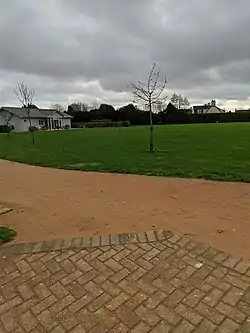 St Martin's Village Green | |
.svg.png.webp) Coat of arms | |
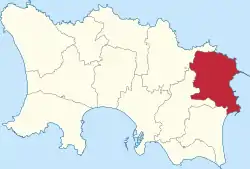 Location of Saint Martin in Jersey | |
| Crown Dependency | Jersey, Channel Islands |
| Government | |
| • Connétable | Karen Shenton-Stone |
| Area | |
| • Total | 10.3 km2 (4.0 sq mi) |
| Area rank | Ranked 6th |
| Population (2011) | |
| • Total | 3,763 |
| • Density | 370/km2 (950/sq mi) |
| Time zone | GMT |
| • Summer (DST) | UTC+01 |
| Postcode district | |
| Postcode sector | 6 |
| Website | parish |
St Martin is the only parish in Jersey not to conduct its municipal business from a Parish Hall. St Martin has a Public Hall instead, having accepted money from the States of Jersey to provide an assembly room.
The village of Gorey is partly located in the parish, with the remainder of the village in Grouville. The village of Maufant is also partly located in St Martin, along the boundary with St Saviour.
History
Historically it was called "Saint Martin le Vieux" to distinguish it from the present day parish of Grouville (historically "Saint Martin de Grouville").

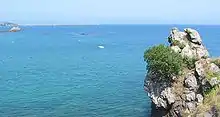
The dolmens at Le Couperon and Faldouet are among the prehistoric remains in the parish. La Pouquelaye de Faldouet features on the reverse of the Jersey ten pence coin (see coins of the Jersey pound) and was the inspiration for the poem Nomen, numen, lumen written by Victor Hugo in 1855 during his exile in Jersey.

There is a significant oyster bed off the coast of Gorey. In the early 19th century, at least 2,000 men were employed in the industry at Gorey, and a number of cottages were built in the village to accommodate the new English residents. This also led to the construction of Gouray Church to provide English services for the residents (most of the Anglican services on the island at the time were delivered in French).[2]:236
The rock known as Le Saut Geffroy, or Geoffroy's Leap, is reputed to be an ancient place of execution where criminals were thrown into the sea. According to folklore, a man named Geffroy was condemned to be thrown into the sea. Remarkably, he survived and climbed back up the cliff face where an argument broke out among the mob of spectators. Some said that sentence had been duly carried out and that Geffroy should go free; others said that sentence had not been properly carried out. To settle the argument, and demonstrate his prowess, Geffroy dived off the rock, but perished on this occasion. Le Saut Geffroy is now preserved by the National Trust for Jersey.
Governance
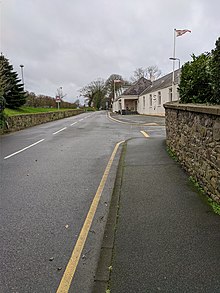
St. Martin is divided into vingtaines as follows:
- La Vingtaine de Rozel
- La Vingtaine de Faldouet
- La Vingtaine de la Quéruée
- La Vingtaine de l'Église
- La Vingtaine du Fief de la Reine
The Écréhous, small group of rocky islands, are part of the parish of St. Martin.
St. Martin forms one electoral district, and elects one deputy. The current deputy is Steve Luce who ousted the long term incumbent Bob Hill in the 2011 election.[3]
Geography
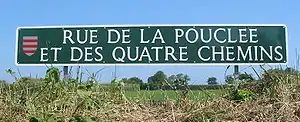
The 600m breakwater at St. Catherine is all that remains of a grandiose harbour project started, but then abandoned, by the British government in the 19th century. It is now a popular site for sea anglers.
This is one of the most agricultural parishes, and one of the most sought after places to live in the island. It has the best herd of Jersey cattle, some of the largest potato growers and a number of small farmers now cultivating the new “Genuine Jersey”, mainly organic, brand.
The main settlements in the parish are the villages of St Martin, Maufant and Gorey. Gorey is split with Grouville. The southern half of Maufant is located within St Martin, however the main road through the village is in St Saviour.
Transport
Gorey Pier is the eastern terminus of the A3 La Rue à Don, which is the main road linking the village to Grouville Church and to St Helier. It was formerly the terminus for the Jersey Eastern Railway.[4]
As part of the Eastern Cycle Network plans, Gorey Village will be connected to St Helier with a direct off-main road cycle route. A cycle path was constructed along the side of La Rue à Don in the Grouville part of Gorey in 2011.[5] Later on, the cycle lane was extended south along the Royal Golf Course (at a cost of £190,000)[6] and north to connect to Gorey Pier along the coast.
St Martin has a very comprehensive green lane network, which are roads that have a 15 mph speed limit and priority is afforded to pedestrians, cyclists and horseriders. Most of the parish-owned by-roads are designated as green lanes.[7] This compares to its neighbouring parishes St Saviour and Trinity, which have no green lanes, and Grouville, which has very few. In 2020, the Connétable Karen Shenton-Stone said St Martin had seen a huge increase in cycling during the Covid-19 lockdown.[8]
Culture
St. Martin is one of the remaining strongholds of Jèrriais with a distinctive accent. The area around Faldouet formerly possessed a dialect of its own, known as Faldouais, of which the distinctive feature was the realisation of intervocalic /r/ as /z/. Although the Faldouais dialect is extinct, it has left notable amounts of writings in Jèrriais literature.
Demographics
| Year | Pop. | ±% |
|---|---|---|
| 1991 | 3,528 | — |
| 1996 | 3,423 | −3.0% |
| 2001 | 3,628 | +6.0% |
| 2011 | 3,763 | +3.7% |
Landmarks
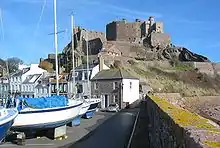
Mont Orgeuil is one of the two main castles in Jersey. First known as Gorey Castle and located near Gorey Pier, it has existed for 800 years. The castle was subject to raids by the French in the 13th, 14th and 15th centuries.[9] The castle served as the island's prison until a prison was constructed in St. Helier in the 17th century. Among agitators imprisoned there by the British government were William Prynne and John Lilburne. Until the construction of Elizabeth Castle off St. Helier at the beginning of the 17th century, Mont Orgueil was generally the residence of the Governor of Jersey.
Famous people
The artist Edmund Blampied was born at Ville Brée on 30 March 1886.
References
- "Election results 2011". Gov.je. Retrieved 5 October 2012.
- Syvret, Marguerite (2011). Balleine's History of Jersey. The History Press. ISBN 978-1860776502.
- "Jersey election 2011: St Martin". Bbc.co.uk. 17 October 2011. Retrieved 5 October 2012.
- "Jersey Eastern Railway - theislandwiki". www.theislandwiki.org. Retrieved 24 February 2018.
- "New cycle path in the east". jerseyeveningpost.com. Retrieved 24 January 2021.
- "Plans unveiled to extend a popular cycle track: Do we need more routes?". jerseyeveningpost.com. Retrieved 24 January 2021.
- "Road Traffic (Speed Limits) (Jersey) Order 2003". www.jerseylaw.je. Retrieved 24 January 2021.
- "All parishes 'need to join the Island's green lane network'". jerseyeveningpost.com. Retrieved 24 January 2021.
- Heritage, Jersey. "Mont Orgueil Castle". JerseyHeritage.org. Retrieved 24 December 2020.
- Jersey Folk Lore, John H. L'Amy, Jersey 1927
External links
| Wikimedia Commons has media related to Saint Martin, Jersey. |